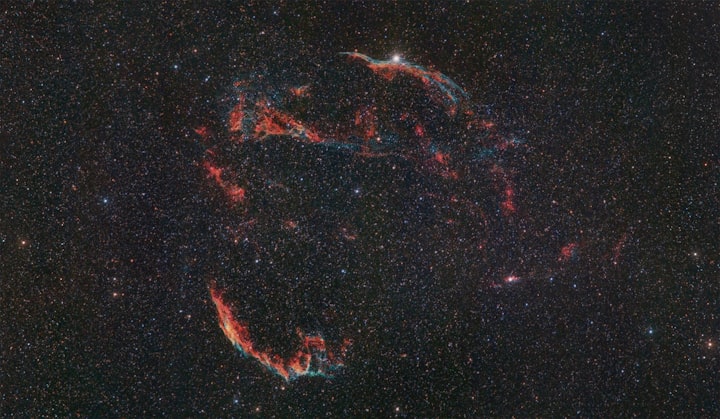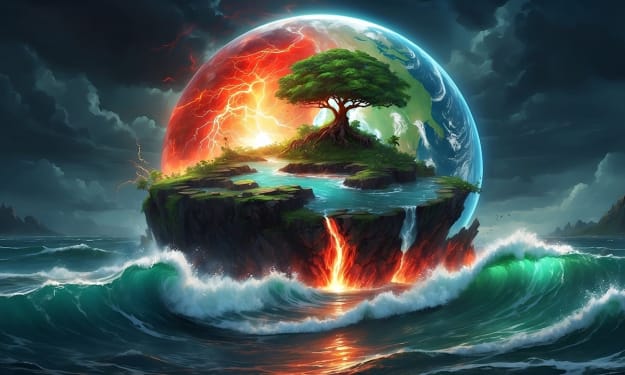THE GREEN MONSTER
The green monster found in space

When I hear the words "green monster," my mind immediately goes to the Hulk and Shrek, but definitely not a young supernova in the Milky Way galaxy. Speaking of which, if you've forgotten what our home galaxy looks like, take a look at this image.
Now, let's talk about the supernova known as Cassiopeia A, or Cass A for short. It is the remnants of a stellar explosion that astronomers observed 340 years ago. Located 11,000 light years away from us in the constellation Cassiopeia, Cass A's remains span about 10 light years. Recently, scientists captured the sharpest image of Cass A's leftovers thanks to the James Webb Space Telescope, the largest optical telescope in space. The image is filled with bright colors, including brilliant green, orange, and pink. If you printed it out, it could make a great painting for your living room, just like this canvas.
Each hue in the image represents a different wavelength of infrared light, which is normally invisible to the human eye. This image can help astronomers understand what happened to the star before its demise. Cass A is the youngest known remnant of a massive star that once exploded in our galaxy.
In the image, you can see curtains of red and orange material at the top and left sides, which are caused by the emission of warm dust when the ejected material from the exploded star collides with the surrounding gas and dust. Inside this outer shell, there are chunks of bright pink, bubble-shaped material that form clumps and knots. This material is shining due to the mix of heavy elements like neon, argon, and oxygen. Astronomers have also observed some dust emissions in that region, but they haven't identified the sources yet.
There's also a prominent green loop extending across the right side of Cass A's central cavity. If you look closely, you'll notice that a big region of Cass A is pockmarked with small bubble-like structures, which adds to its complexity and makes it harder to understand.
The first X-rays from Cass A were detected in the 1960s, but the light from the supernova likely reached Earth in the 1600s. Unfortunately, there are no confirmed written observations of the supernova from that time. It must have appeared as an extremely bright star, but historians still doubt whether any observers noticed it. By the way, the nickname "green monster" comes from Fenway Park in Boston, which has a large green left field wall with the same name.
One of the main questions Cass A might help answer is where all the cosmic dust comes from. Astronomers have discovered that even very young galaxies are filled with massive amounts of dust, but the origin of this dust is still a puzzle. One of the key components in the formation of this dust seems to be supernova explosions, which release large amounts of heavy elements, the building blocks of dust, into the cosmos.
Now, let's delve into what supernovae are and how they occur. When a star becomes too old and massive, about four to eight times the size of our sun, it runs out of fuel. The reactions in its core stop, and its outer layers instantly collapse inward, bouncing off the incredibly dense core. This results in a supernova explosion where everything but the star's core is blasted out into the universe.
Supernova explosions unleash enormous amounts of energy, making the temperature at the core of a supernova about 6,000 times higher than the sun's core. This means it can reach several billion degrees Fahrenheit within microseconds. Atoms in the core get crammed together so closely that the squeezed core recoils and a star explodes, creating a superheated shock wave.
Returning to Cass A, by studying it with the James Webb Telescope, astronomers hope to gain a better understanding of its dust content, which will help them determine the origin of the building blocks of stars, planets, and even us humans. Dust from supernovae plays a vital role in the formation of elements like calcium and iron, which are essential for life as we know it. In a way, we are made from star stuff.
Not all stars end in supernovae, though. Some stars survive the explosion and become either black holes or new kinds of stars called neutron stars. Neutron stars are incredibly dense, with their mass consisting of 90 percent neutrons. These compact objects can be as small as 12 miles across, but they can weigh one and a half times more than the sun. If the core of a star collapses even further during a supernova, it can transform into a neutron star, emitting enormous amounts of energy in the form of neutrinos.
Space is indeed an endless source of mystery and inspiration. I'm even considering adding some space-themed decor to my home.





Comments
There are no comments for this story
Be the first to respond and start the conversation.